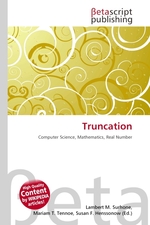Truncation
Lambert M. Surhone, Miriam T. Timpledon, Susan F. Marseken
бумажная книга
High Quality Content by WIKIPEDIA articles! In mathematics and computer science, truncation is the term for limiting the number of digits right of the decimal point, by discarding the least significant ones. In statistics, truncation results in values that are limited above or below, resulting in a truncated sample. Truncation is similar to but distinct from the concept of statistical censoring. A truncated sample can be thought of as being equivalent to an underlying sample with all values outside the bounds entirely omitted, with not even a count of those omitted being kept. If the sample had been censored, a record would be of those that were censored, consisting of a note that of whether the lower or upper bound had been passed and the value of the bound. Usually the values that insurance adjusters receive are either left-truncated, right-censored or both. For example, if policyholders are subject to a policy limit u, then any loss amounts that are actually above u are reported to the insurance company as being exactly u because u is the amount the insurance companies pay.
Данное издание не является оригинальным. Книга печатается по технологии принт-он-деманд после получения заказа.


